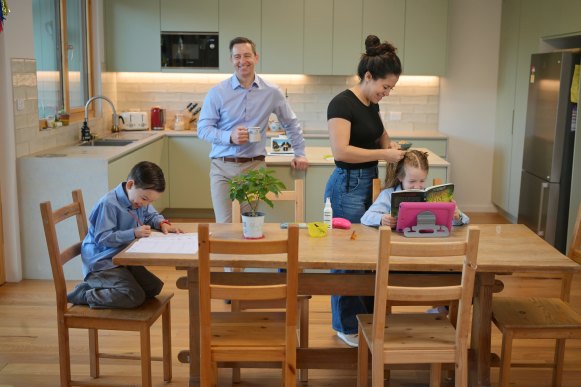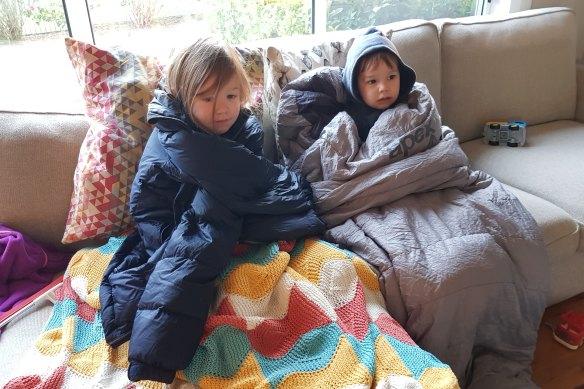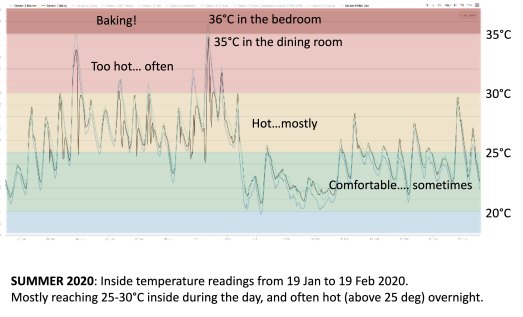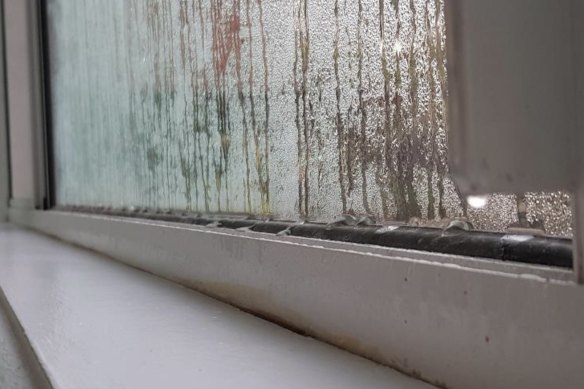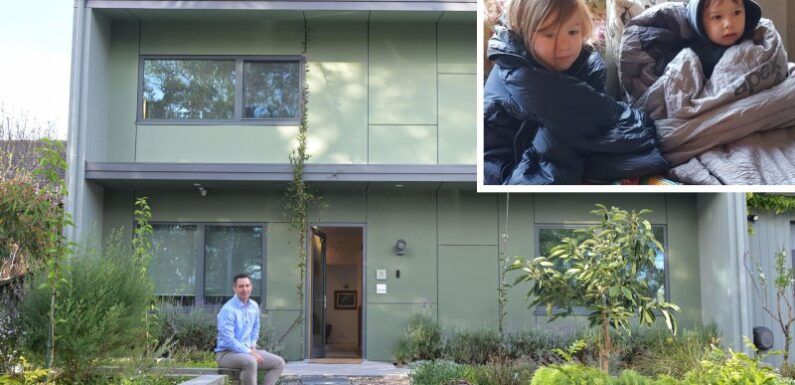
Save articles for later
Add articles to your saved list and come back to them any time.
Like many Sydney homes built in the 1950s, the temperature inside Chris and Maylynne Nunn’s poorly insulated weatherboard cottage in Asquith was measured in degrees of misery. It bottomed out at a bitterly cold 7 degrees in winter, and rose to 35 degrees in summer.
“It was completely miserable,” Chris Nunn said. “We wore our ugg boots, down jackets and had little plug-in electric radiators, and we would muddle through winter until it got better. And all of a sudden, we’re overheating in summer, and sweltering and miserable again.”
Chris and Maylynne Nunn with children Frankie and Axel in their new home in Asquith in Sydney’s north. The first Green Star accredited home in Australia, it was built to cut heating and cooling bills with double glazing, solar power, heat transfer and air purification.Credit: Nick Moir
The temperature was often worse inside than out, it cost thousands to heat and cool and, when the house was demolished, black mould was found growing in walls from the condensation.
A study has found that building an energy-efficient home may cost more, but it saves on energy costs and helps homeowners repay their mortgages faster.
Commissioned by Green Building Council Australia from consultants KPMG, the computer modelling found owners of an average-sized home could save as much as $115,000 in interest costs over the life of an average loan.
KPMG compared the energy costs of identical homes – based on a standard single-storey project home in a housing development in Canberra, Melbourne and Sydney – with homes that met the Green Star standard.
The Nunns’ children had to bundle up in their sleeping bags to keep warm in the old weatherboard home that lacked insulation.Credit: Chris Nunn
Green Star homes have light-coloured roofs, solar panels, double-glazed windows, improved insulation, a heat recovery ventilation system – which removes pollution and bushfire smoke that seeped into the Nunns’ home – and air-conditioning.
Building to the Green Star standard would usually increase loan repayments by $38 to $84 a month, but that would be offset by the savings in energy costs of $90 to $140 a month, the modelling showed.
Compared with a standard project home, KPMG forecast reductions in energy consumption in the first year of a green building’s life of 60 per cent, 56 per cent and 56 per cent in Sydney, Canberra and Melbourne respectively, and falls in greenhouse emissions of 37 per cent, 33 per cent and 28 per cent, respectively.
With energy costs expected to increase, the benefits to consumers of a more energy-efficient home would increase over time.
Chris Nunn’s record of the extremes in temperature in his old 1950s weatherboard house, typical of many in Australia.Credit: Chris Nunn
The chief executive of Green Building Council Australia, Davina Rooney, said it had always known a Green Star home was better for the planet and for occupants’ health.
“Now we have independent modelling to show that it is also better for your hip pocket,” she said.
Research showed that people were willing to invest in more energy-efficient homes, she said.
“An energy-efficient home commands a premium on the sale price of up to 10 per cent, according to research from the University of Wollongong,” she said.
Condensation caused mould to grow inside and behind the walls of the Nunns’ old weatherboard house. Credit: Chris Nunn
Chris Nunn said his old home was typical of many Australian homes. The weatherboard cottage in Sydney’s north had no insulation in the walls or under the floorboards, it had single glazed windows and no external shading, and it used 10 times as much energy to run as the new home he built on the same block for his family.
It was far from the healthy indoor temperature range of 18 to 24 degrees recommended by the World Health Organisation.
Nunn is a sustainability expert and the general manager of environment, social and governance at Scape, which builds student housing. He decided to practise what he preached when he built the new house.
“[The new house] has perfect temperatures of 20 to 25 degrees inside year round, and heating and cooling are only required on extreme days,” he said.
The two-year-old home was the first Green Star home to meet the standard established by the Green Building Council.
“Humidity is always right. You just cannot get condensation or mould because of the way that the construction is done, with double-glazed windows, air tightness, sealing and improved insulation.”
The discounted green home loan was an extra incentive, he said.
“You can access cheaper interest rates by having a clean energy home loan. So, the interest rate payments are lower. Plus we are literally saving $2000 to $3000 a year on energy bills [the cost in 2019], which is more disposable income that you can put towards your home loan.”
The Morning Edition newsletter is our guide to the day’s most important and interesting stories, analysis and insights. Sign up here.
Most Viewed in Environment
From our partners
Source: Read Full Article
